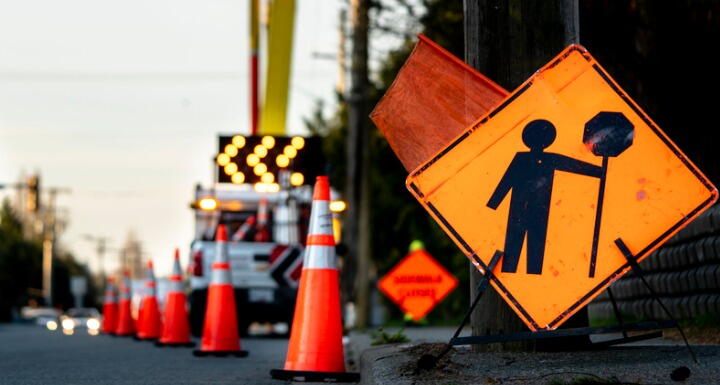Roadway Construction Zone Accidents in North Carolina

North Carolina’s population continues to grow, and that means more highways and other roads being built for our increasing population.
Also, existing roadways often need maintenance or rehabilitation. This work often is completed while motorists continue to use the roadway—leading to the possibility of car wrecks or other accidents. When an accident happens in a construction zone, victims or their families often wonder what their rights are: Is someone legally liable? In North Carolina this question hinges on whether another party was “negligent” or otherwise acted wrongfully, and whether that negligence caused actual damages to the injured party. In roadway construction cases, this analysis can become very complex.
The safety of the workers themselves in a construction zone is paramount, and all drivers should do what they can to keep those workers safe. This article, however, focuses on injuries to innocent third-parties in a construction zone, particularly drivers and their passengers.
The Role of “Negligence”
Whether someone in a roadway construction zone is liable for an accident depends on whether the potentially at-fault party was “negligent.” When someone fails to act with reasonable care, and their actions cause injury, that party is deemed to be negligent. Unless a legal defense applies, a negligent party is legally liable for the damages their negligence causes.
Again, there are potential defenses. For instance, North Carolina is one of only a few states that recognizes the doctrine of “contributory negligence.” That doctrine provides that if the injured party negligently contributed to the incident in the slightest manner—even 1%—the injured party cannot recover at all. There are exceptions to this defense, such as the doctrine of “last clear chance,” or possibly when the acting party is found to be not just negligent, but “grossly negligent.”
So, to determine who may be at-fault for an accident in a construction zone, the analysis involves whether someone was negligent, and whether that negligence caused the accident.
Possible At-Fault Parties in a Roadway Construction Zone Accident
There are numerous possible at-fault parties in a construction zone accident. Other drivers certainly could be liable. There often are specific duties to maintain lower speeds and keep a proper lookout when driving through a construction zone. When another driver fails to do so, they may be negligent. And if they cause an accident, they are responsible for an innocent party’s injuries.
There can be other causes of accidents in a construction zone. These causes can include:
- Dangerous traffic backups;
- Inadequate warning signs;
- Misplaced warning signs;
- Improperly designed traffic detours;
- Negligently designed construction plans, including traffic management plans;
- Improper use of construction equipment;
- Negligent construction that creates dangers to motorists (materials in roadway, blocked visibility, etc.);
- Inadequate inspection of the construction activities; and
- Any other actions or inactions in the work zone that pose an unreasonable risk to motorists, and foreseeably could cause an accident.
When the construction activities themselves are the cause of an injury, it can be complicated to determine who is at fault. The North Carolina Department of Transportation or another governmental entity may be responsible. These often are government projects, and state or local departments often have some retained responsibility for oversight, inspections, or signage. Still, private contractors typically are involved.
Identifying which contractors were involved for which construction activities can be complicated, and may require extensive investigation, public records requests, or utilizing the discovery process in a lawsuit. There also may be multiple responsible parties. North Carolina follows the rule of joint and several liability. Every party that was negligent is responsible for the full amount of an injured party’s damages.
Numerous sources may inform the standards that should have been followed on the roadway construction project, and therefore shed light on potential mistakes that were made. These sources may include case law, regulations, the contracts and subcontracts between the parties, and certain state and federal materials such as the North Carolina Standard Specifications for Roads and Structures, Standard Drawings, and the Manual on Uniform Traffic Control Devices (MUTCD). Often it is necessary to retain experts to examine these issues and opine on whether mistakes were made on the construction project, and the effects of those mistakes. Thus, the liability analysis in these cases can be very complex and time-consuming.
Elements of Damages
Once negligence is proven, the law must determine what damages are owed to the injured party. The aim of awarding damages is to make the injured person “whole” under the law. No amount of money can ever compensate someone for a serious, permanent injury or death. Still, the only option our civil legal system has to compensate an injured party is through the payment of money.
So, the payment of money is how the law compensates for bodily injury and death to “balance the harm” incurred. The negligent party or their insurance company, if applicable, is responsible for paying these damages.
With personal injuries, multiple types of damages may apply. These include past and present medical bills, as well as any future medical costs. The victim also may be entitled to lost wages or a claim for diminished future earning capacity due to ongoing health problems arising from the injuries sustained.
There also are non-economic damages meant to compensate for pain and suffering, scarring or disfigurement, loss of use of a body part, or the permanency associated with any continuing injuries. It is up to the parties (or their insurance companies), a judge, or a jury to determine a reasonable amount of compensation for these damages based on the specific facts of the case.
Conclusion
Construction projects on our highways and other roads can create dangerous situations that can lead to an increased risk of accidents. When another driver, those responsible for the construction plans, or those responsible for the actual construction activities are at-fault for an accident and someone is injured, the negligent party is legally liable for the damages caused. These cases can be very complex. Involving an experienced, committed attorney will ensure the protection of the injured party’s rights, and that the injured party also has skilled guidance during a complex and challenging legal process.
—
© 2022 Ward and Smith, P.A. For further information regarding the issues described above, please contact Jeremy M. Wilson.
This article is not intended to give, and should not be relied upon for, legal advice in any particular circumstance or fact situation. No action should be taken in reliance upon the information contained in this article without obtaining the advice of an attorney.
We are your established legal network with offices in Asheville, Greenville, New Bern, Raleigh, and Wilmington, NC.
Featured News
View All
